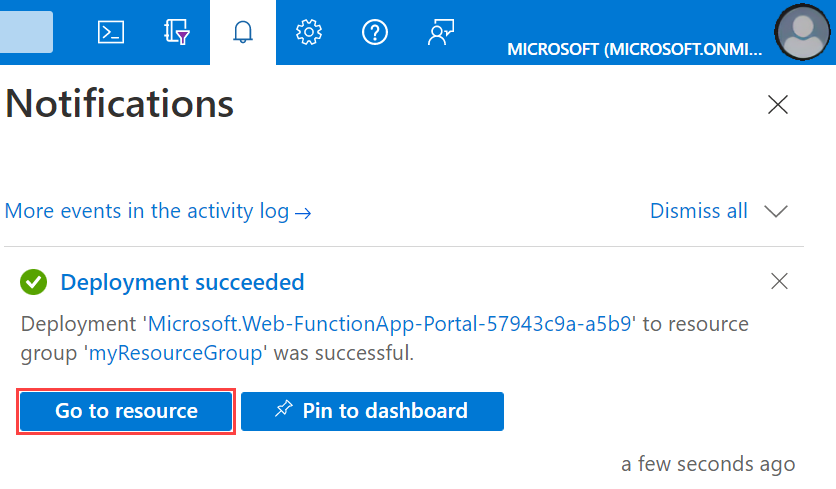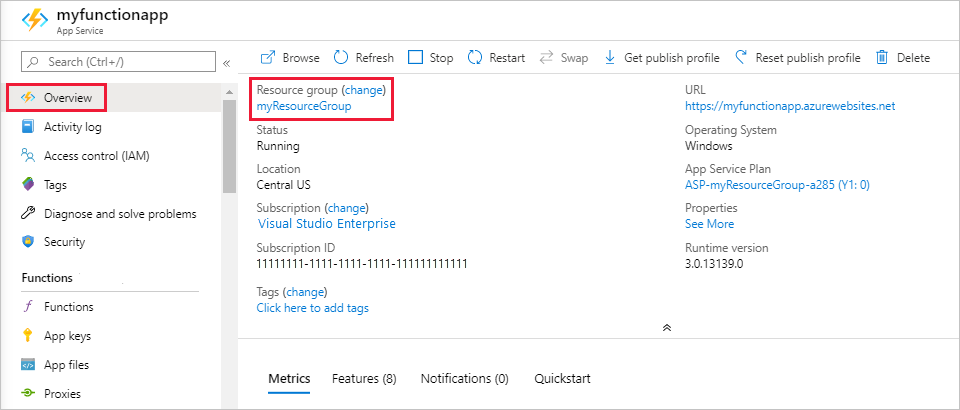Create your first function in the Azure portal
Azure Functions lets you run your code in a serverless environment without having to first create a virtual machine (VM) or publish a web application. In this article, you learn how to use Azure Functions to create a "hello world" HTTP trigger function in the Azure portal.
Choose your preferred programming language at the top of the article.
Note
Editing your C# function code in the Azure portal is currently only supported for C# script (.csx) functions. To learn more about the limitations on editing function code in the Azure portal, see Development limitations in the Azure portal.
You should instead develop your functions locally and publish to a function app in Azure. Use one of the following links to get started with your chosen local development environment:
Note
Editing your Java function code in the Azure portal isn't currently supported. For more information, see Development limitations in the Azure portal.
You should instead develop your functions locally and publish to a function app in Azure. Use one of the following links to get started with your chosen local development environment:
Note
Because of development limitations in the Azure portal, you should instead develop your functions locally and publish to a function app in Azure. Use one of the following links to get started with your chosen local development environment:
Note
Because of development limitations in the Azure portal, you should instead develop your functions locally and publish to a function app in Azure. Use one of the following links to get started with your chosen local development environment:
Note
Editing your TypeScript function code in the Azure portal isn't currently supported. For more information, see Development limitations in the Azure portal.
You should instead develop your functions locally and publish to a function app in Azure. Use one of the following links to get started with your chosen local development environment:
Note
Because of development limitations in the Azure portal, you should instead develop your functions locally and publish to a function app in Azure. Use one of the following links to get started with your chosen local development environment:
Please review the known issues for development of Azure Functions using Python in the Azure portal.
Prerequisites
If you don't have an Azure subscription, create an Azure free account before you begin.
Sign in to Azure
Sign in to the Azure portal with your Azure account.
Create a function app
You must have a function app to host the execution of your functions. A function app lets you group functions as a logical unit for easier management, deployment, scaling, and sharing of resources.
Use these steps to create your function app and related Azure resources, whether or not you're able to edit your code in the Azure portal.
To be able to create a C# script app that you can edit in the portal, choose 8 (LTS), in-process model for .NET Version.
From the Azure portal menu or the Home page, select Create a resource.
In the New page, select Compute > Function App.
Under Select a hosting option, select Consumption > Select to create your app in the default Consumption plan. In this serverless hosting option, you pay only for the time your functions run. Premium plan also offers dynamic scaling. When you run in an App Service plan, you must manage the scaling of your function app.
On the Basics page, use the function app settings as specified in the following table:
Setting Suggested value Description Subscription Your subscription The subscription under which you create your new function app. Resource Group myResourceGroup Name for the new resource group in which you create your function app. You should create a new resource group because there are known limitations when creating new function apps in an existing resource group. Function App name Globally unique name Name that identifies your new function app. Valid characters are a-z(case insensitive),0-9, and-.Runtime stack Preferred language Choose a runtime that supports your favorite function programming language. In-portal editing is only available for JavaScript, PowerShell, Python, TypeScript, and C# script.
To create a C# Script app that supports in-portal editing, you must choose a runtime Version that supports the in-process model.
C# class library and Java functions must be developed locally.Version Version number Choose the version of your installed runtime. Region Preferred region Select a region that's near you or near other services that your functions can access. Operating system Windows An operating system is preselected for you based on your runtime stack selection, but you can change the setting if necessary. In-portal editing is only supported on Windows. Accept the default options in the remaining tabs, including the default behavior of creating a new storage account on the Storage tab and a new Application Insight instance on the Monitoring tab. You can also choose to use an existing storage account or Application Insights instance.
Select Review + create to review the app configuration you chose, and then select Create to provision and deploy the function app.
Select the Notifications icon in the upper-right corner of the portal and watch for the Deployment succeeded message.
Select Go to resource to view your new function app. You can also select Pin to dashboard. Pinning makes it easier to return to this function app resource from your dashboard.

Next, create a function in the new function app.
Create an HTTP trigger function
In your function app, select Overview, and then select + Create under Functions. If you don't see the + Create button, you can instead create your functions locally.
Under Select a template, scroll down and choose the HTTP trigger template.
In Template details, use
HttpExamplefor New Function, select Anonymous from the Authorization level drop-down list, and then select Create.Azure creates the HTTP trigger function. Now, you can run the new function by sending an HTTP request.
Create your functions locally
If you aren't able to create your function code in the portal, you can instead create a local project and publish the function code to your new function app.
In your function app, select Overview, and then in Create functions in your preferred environment under Functions.
Choose your preferred local development environment and follow the steps in the linked article to create and publish your first Azure Functions project.
Tip
When publishing your new project, make sure to use the function app and related resources you just created.
Test the function
Tip
The Code + Test functionality in the portal works even for functions that are read-only and can't be edited in the portal.
On the Overview page for your new function app, select your new HTTP triggered function in the Functions tab.
In the left menu, expand Developer, select Code + Test, and then select Test/Run.
In the Test/Run dialog, select Run.
An HTTP POST request is sent to your new function with a payload that contains the
namevalue ofAzure. You can also test the function by selecting GET for HTTP method and adding anameparameter with a value ofYOUR_NAME.Tip
To test in an external browser, instead select Get function URL, copy the default (Function key) value, add the query string value
&name=<YOUR_NAME>to the end of this URL, and then submit the URL in the address bar of your web browser.When your function runs, trace information is written to the logs. To see the trace output, return to the Code + Test page in the portal and expand the Logs arrow at the bottom of the page. Call your function again to see the trace output written to the logs.
Clean up resources
Other quickstarts in this collection build upon this quickstart. If you plan to work with subsequent quickstarts, tutorials, or with any of the services you've created in this quickstart, don't clean up the resources.
Resources in Azure refer to function apps, functions, storage accounts, and so forth. They're grouped into resource groups, and you can delete everything in a group by deleting the group.
You've created resources to complete these quickstarts. You might be billed for these resources, depending on your account status and service pricing. If you don't need the resources anymore, here's how to delete them:
In the Azure portal, go to the Resource group page.
To get to that page from the function app page, select the Overview tab, and then select the link under Resource group.

To get to that page from the dashboard, select Resource groups, and then select the resource group that you used for this article.
In the Resource group page, review the list of included resources, and verify that they're the ones you want to delete.
Select Delete resource group and follow the instructions.
Deletion might take a couple of minutes. When it's done, a notification appears for a few seconds. You can also select the bell icon at the top of the page to view the notification.
Next steps
Now that you've created your first function, let's add an output binding to the function that writes a message to a Storage queue.